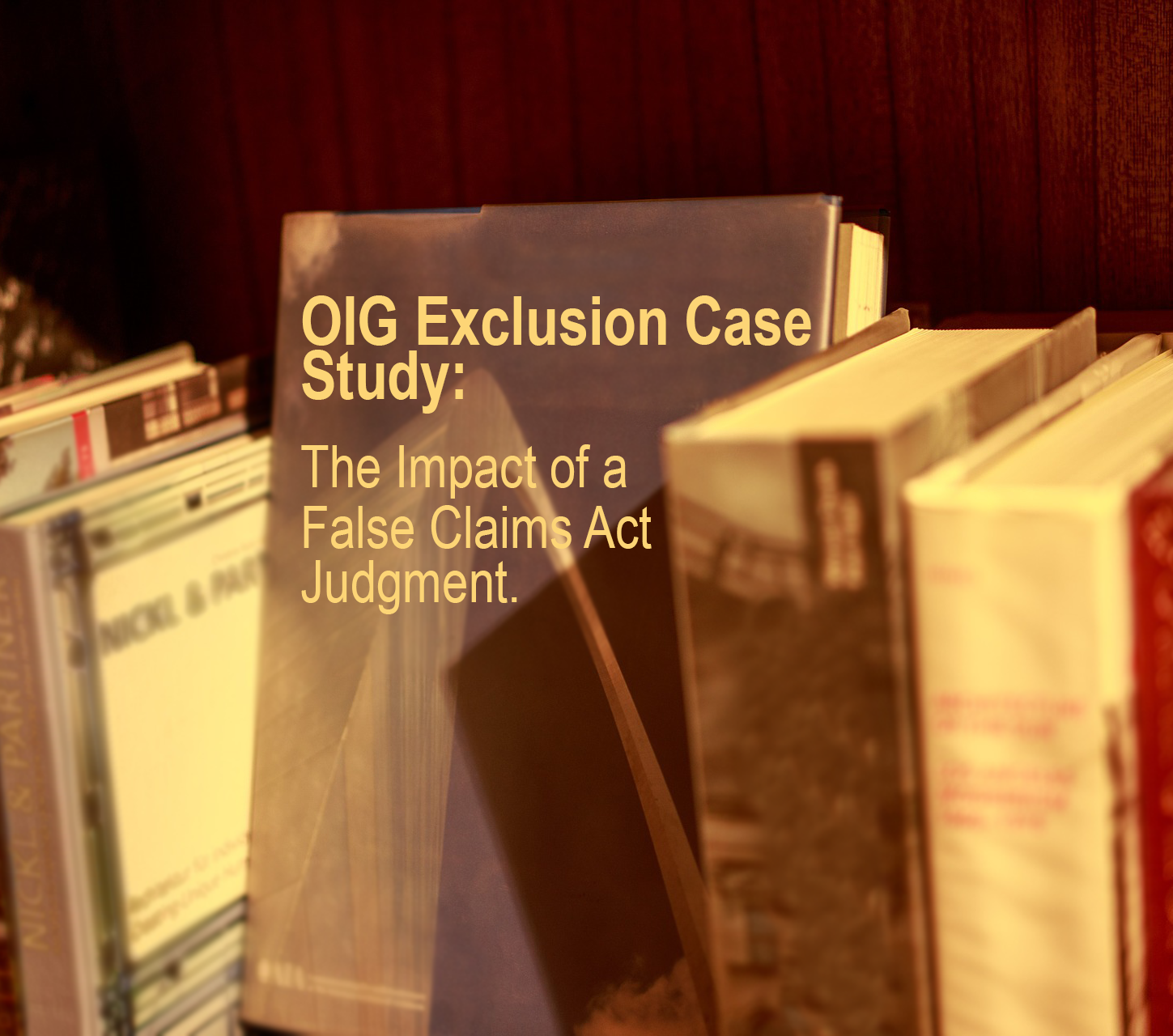 (August 23, 2018): In 2008, after learning that a Texas-based laboratory services company was submitting false claims to the Medicare program, a private citizen filed suit, on behalf of the United States, against the laboratory services company under the qui tam provisions of the civil False Claims Act. The qui tam provisions of the False Claims Act (31 U.S.C. §§ 3729 – 3733) allow private parties, commonly referred to as “whistleblowers” or “relators” to sue individuals and entities on behalf of the government if the defendants have “knowingly” submitted false claims to the government for payment.[1] In this case, the United States intervened in the case against the laboratory services company in 2011. In April 2018, the U.S. District Judge hearing the case ruled against the laboratory and its physician owner and awarded the United States $30.5 million for violations of the False Claims Act. Although there are a number of lessons (especially with respect to individual liability) to be learned from the underlying case, the purpose of this article to examine the collateral administrative actions that were taken against the physician owner and the laboratory services company.
(August 23, 2018): In 2008, after learning that a Texas-based laboratory services company was submitting false claims to the Medicare program, a private citizen filed suit, on behalf of the United States, against the laboratory services company under the qui tam provisions of the civil False Claims Act. The qui tam provisions of the False Claims Act (31 U.S.C. §§ 3729 – 3733) allow private parties, commonly referred to as “whistleblowers” or “relators” to sue individuals and entities on behalf of the government if the defendants have “knowingly” submitted false claims to the government for payment.[1] In this case, the United States intervened in the case against the laboratory services company in 2011. In April 2018, the U.S. District Judge hearing the case ruled against the laboratory and its physician owner and awarded the United States $30.5 million for violations of the False Claims Act. Although there are a number of lessons (especially with respect to individual liability) to be learned from the underlying case, the purpose of this article to examine the collateral administrative actions that were taken against the physician owner and the laboratory services company.
I. Parallel Administrative Action — OIG Exclusion Action Overview:
II. Why Did the OIG Exercise its Exclusion Authority Under 1128(b)(7)?
More often than not, when dealing with allegations of the civil False Claims Act, the OIG will choose to exercise its permissive discretion to exclude an individual or entity under Section 1128(b)(7) of the Social Security Act.[4] In this particular case, the OIG did, in fact, exercise its authority to exclude the Petitioners for 15 years.
III. Petitioners’ Appeal of the OIG’s Exclusion Decision:
In response to the proposed OIG exclusion action, in October 2015, the Petitioners filed a timely request for a hearing before an Administrative Law Judge (ALJ). Additionally, due to the unavailability of the ALJ first assigned to hear the case, a different ALJ was appointed to handle the hearing on June 2017. Throughout this period (from late 2015 to early March 2018), both sides actively engaged in discovery and a lively exchange of motions ensued. Finally, in late March 2018, the substitute ALJ assigned to take over the case conducted an in-person hearing on the exclusion action.
IV. Issues Considered by the Administrative Law Judge:
(1) Petitioners presented or caused to be presented to an agency of the United States the claims at issue in this case.
(2) The claims Petitioners presented or caused to be presented to Medicare were false.
(3) Petitioners should have known that the claims for services they presented or caused to be presented to Medicare were false.
(4) Petitioners’ equitable defenses do not serve to undermine the OIG’s basis for excluding them.
(5) The statute of limitations is not implicated by discussion of Petitioners’ conduct preceding the six-year timeframe that forms the basis of the proposed exclusion.[7]
utlined under 42 C.F.R. §1001.901(b)(1)-(5): [8]
V. Points Learned from this Exclusion Case:
Point #1. Impact of a False Claims Act Judgment. The administrative collateral risks associated with violations of the False Claims Act cannot be underestimated. In this case, where the False Claims Act violations went to trial and resulted in a judgment, the OIG had no reason to waive its permissive exclusion authority. How could this have been avoided? It is important to keep in mind that the vast majority of cases brought by whistleblowers / relators under the civil False Claims Act are not intervened by the government and result in the dismissal of the case. Of the False Claims Act cases that are intervened, most result in a settlement with the government. When settling a False Claims Act case, defense counsel will often seek to wrap-up any outstanding administrative risks (such as exclusion) as well. In order to waive its permissive exclusion authority, the OIG typically requires that health care providers and entities enter into a Corporate Integrity Agreement (CIA) as part of the settlement. In this case, for whatever reason, the False Claims Act case was not settled and went to trial, resulting in a significant judgment and the imposition of a 15-year exclusion.
Point #2: Issue Preclusion is a Real Possibility. As you will recall, the U.S. District Court in the associated False Claims Act case granted the OIG’s Motion for Summary Judgment. In asserting its arguments in the administrative hearing, the OIG urged the ALJ to narrowly apply estoppel and rely on the District Court’s finding that the claims submitted by the Petitioners were false. The ALJ cited several reasons for not adopting the District Court’s holding in this regard. Nevertheless, it isn’t much of a stretch to imagine a slightly different set of facts, where issue preclusion may have been granted. For instance, if the judgment was final and the time period of the claims at issue were the same, the ALJ may have been persuaded to apply estoppel in this case.
Point #3: ALJs will Give Broad Deference to the OIG When Assessing the Reasonableness of an Exclusion Action. It is important to remember that when making this type of determination, an ALJ is limited to a significant extent and cannot substitute his judgment for that of the OIG. Inst
ead, the ALJ can only consider whether the period of exclusion was within a “reasonable range.”[10] As discussed in the Federal Register more than 25 years ago:
The OIG’s broad discretion is also reflected in the language of § 1001.2007(a)(2), restricting the ALI’s authority to review the length of an exclusion imposed by the OIG. Under that section, the ALI’s authority is limited to reviewing whether the length is unreasonable. So long as the amount of time chosen by the OIG is within a reasonable range, based on demonstrated criteria, the ALI has no authority to change it under this rule. We believe that the deference § 1001.2007(a)(2) grants to the OIG is appropriate, given the OIG’s vast experience in implementing exclusions under these authorities.[11]
VI. Conclusion:
Need help conducting your monthly required Exclusion Screening? Call us at 1-800-294-0952 or fill out the form below for a free quote and assessment fo your needs.
 Robert W. Liles serves as Managing Partner at the health law firm, Liles Parker, Attorneys and Counselors at Law. Liles Parker attorneys represent health care providers and suppliers around the country in connection with UPIC audits, ZPIC audits, OIG investigations and Medicare exclusion actions. Is your practice facing alleged violations of the False Claims Act? We can help. For a free initial consultation regarding your situation, call Robert at: 1 (800) 475-1906.
Robert W. Liles serves as Managing Partner at the health law firm, Liles Parker, Attorneys and Counselors at Law. Liles Parker attorneys represent health care providers and suppliers around the country in connection with UPIC audits, ZPIC audits, OIG investigations and Medicare exclusion actions. Is your practice facing alleged violations of the False Claims Act? We can help. For a free initial consultation regarding your situation, call Robert at: 1 (800) 475-1906.
[1] Under the qui tam provisions of the False Claims Act, whistleblowers can are entitled to receive 15% to 25% of any recovery if the United States intervenes in the case, or 25% to 30% if the government declines to intervene in the case that the whistleblower has brought. Defendants who violate the civil False Claims Act are liable for three times the government’s damages plus significant civil penalties for each false claim that was improperly submitted for payment.
[2] Section 1128(b)(7) of the Social Security Act
[3] ALJ decision, citing Petitioner’s Request for Hearing, Ex. A at 2.
[4] In those cases where the OIG concludes that exclusion is not necessary in order to protect the integrity of the Medicare program, it will typically require that the individual and / or entity enter into a Corporate Integrity Agreement (CIA). The purpose of the CIA is to strengthen the provider’s compliance program and reduce the level of risk to the Medicare program.
[5] Under 42 U.S.C. §1320a-7(b)(f), “Federal health care program” is defined as:
(1) any plan or program that provides health benefits, whether directly, through insurance, or otherwise, which is funded directly, in whole or in part, by the United States Government (other than the health insurance program under Chapter 89 of Title 5); or
(2) any State health care program, as defined in section 1320a-7(h).
[6] The Secretary has delegated the authority to impose an exclusion to the OIG, pursuant to: 42 C.F.R. §1001.901(a).
[7] 42 C.F.R. §1001.901(b)(1)-(5).
[8] An abbreviated set of these five criteria were set out in the OIG’s Final Rule, ”Medicare and State Health Care Programs: Fraud and Abuse; Revisions to the Office of Inspector General’s Civil Monetary Penalty Rule.” See 81 Fed. Reg. 88,334 (Dec. 7, 2016). The full regulatory language of 42 C.F.R. §1001.901(b)(1)-(5) reads as follows:
“(b) Length of exclusion. In determining the length of an exclusion imposed in accordance with this section, the OIG will consider the following factors—
(1) The nature and circumstances surrounding the actions that are the basis for liability, including the period of time over which the acts occurred, the number of acts, whether there is evidence of a pattern and the amount claimed;
(2) The degree of culpability;
(3) Whether the individual or entity has a documented history of criminal, civil or administrative wrongdoing (The lack of any prior record is to be considered neutral);
(4) The individual or entity has been the subject of any other adverse action by any Federal, State or local government agency or board, if the adverse action is based on the same set of circumstances that serves as the basis for the imposition of the exclusion; or
(5) Other matters as justice may require.”
[9] Under 42 C.F.R. §1001.901(b)(4), an “individual or entity has been the subject of any other adverse action by any Federal, State or local government agency or board, if the adverse action is based on the same set of circumstances that serves as the basis for the imposition of the exclusion.”
[10] Craig Richard Wilder, DAB No. 2416 at 8.
[11] Federal Register Final Rule, “Health Care Programs; Fraud and Abuse; Amendments to OIG Exclusion and CMP Authorities Resulting from Public Law 100-93. 57 Fed. Reg. 3298, 3321 (January 29, 1992).